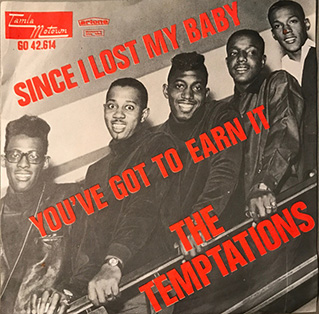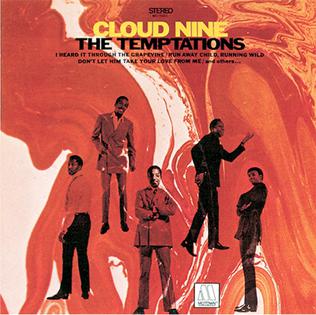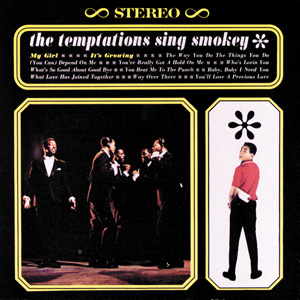
The Temptations are an American vocal group from Detroit, Michigan, who released a series of successful singles and albums with Motown Records during the 1960s to mid 1970s. The group's work with producer Norman Whitfield, beginning with the Top 10 hit single "Cloud Nine" in October 1968, pioneered psychedelic soul, and was significant in the evolution of R&B and soul music. The band members are known for their choreography, distinct harmonies, and dress style. Having sold tens of millions of albums, the Temptations are among the most successful groups in popular music.

Edward James Kendrick, better known as Eddie Kendricks, was an American tenor singer and songwriter. Noted for his distinctive falsetto singing style, Kendricks co-founded the Motown singing group the Temptations, and was one of their lead singers from 1960 until 1971. He was the lead voice on such famous songs as "The Way You Do the Things You Do", "Get Ready", and "Just My Imagination ". As a solo artist, Kendricks recorded several hits of his own during the 1970s including the number-one singles "Keep On Truckin'" and "Boogie Down."

"Get Ready" is a Motown song written by Smokey Robinson, which resulted in two hit records for the label: a U.S. No. 29 version by The Temptations in 1966, and a U.S. No. 4 version by Rare Earth in 1970. It is significant for being the last song Robinson wrote and produced for the Temptations, due to a deal Berry Gordy made with Norman Whitfield, that if "Get Ready" did not meet with the expected degree of success, then Whitfield's song, "Ain't Too Proud to Beg", would get the next release, which resulted in Whitfield more or less replacing Robinson as the group's producer.

"Ain't Too Proud to Beg" is a 1966 song and hit single by The Temptations for Motown Records' Gordy label, produced by Norman Whitfield and written by Whitfield and Edward Holland Jr. The song peaked at number 13 on the Billboard Pop Chart, and was a number-one hit on the Billboard R&B charts for eight non-consecutive weeks. The song's success, in the wake of the relative underperformance of the previous Temptations' single, "Get Ready", resulted in Norman Whitfield replacing Smokey Robinson, producer of "Get Ready", as The Temptations' main producer. In 2004 it finished number 94 in AFI's 100 Years...100 Songs poll thanks to its inclusion in The Big Chill soundtrack.

"Since I Lost My Baby" is a 1965 hit single recorded by The Temptations for the Motown Records' Gordy label. Written by Miracles members Smokey Robinson and Pete Moore and produced by Robinson, the song was a top 20 pop single on the Billboard Hot 100 in the United States, on which it peaked at number 17. On Billboard's R&B singles chart, "Since I Lost My Baby" peaked at number four.
"My Baby" is a 1965 hit single recorded by The Temptations for the Gordy (Motown) label. Written by Miracles members Smokey Robinson, Bobby Rogers, and Pete Moore and produced by Robinson, the song was a top 20 pop hit in the United States, and a top 5 hit on the R&B charts.
"Don't Look Back" is a 1965 song recorded by The Temptations for the Gordy (Motown) label. The flip side to their Top 20 hit "My Baby", "Don't Look Back" broke out and became a hit among the R&B audience on its own, reaching #14 on the R&B charts.

"The Way You Do the Things You Do" is a 1964 hit single by the Temptations for the Gordy (Motown) label. Written by Miracles members Smokey Robinson and Bobby Rogers, the single was the Temptations' first charting single on the Billboard Hot 100, peaking in the Top 20 at number eleven; it also went to number one on the Cash Box R&B chart. The song has been an American Top 40 hit in four successive decades, from the 1960s to the 1990s. A version by Hall & Oates featuring Temptation members Eddie Kendricks and David Ruffin was nominated for a Grammy Award in 1986. A cover version by British reggae band UB40 hit number six in the U.S. in 1990.

Meet the Temptations is the debut studio album by the Temptations for the Gordy (Motown) label released in 1964. It includes most of the group's early singles, excluding only the first, "Oh Mother of Mine", and its b-side, "Romance Without Finance" ; as well as the single "Mind Over Matter", in which the group is credited as The Pirates. The album consists entirely of previously released singles, including the group's first hit single, "The Way You Do the Things You Do".

Cloud Nine is the ninth studio album by American musical group The Temptations for the Gordy (Motown) label released in 1969.

Diana Ross & the Supremes Join the Temptations is a collaborative album combining Motown's two best selling groups, Diana Ross & the Supremes and the Temptations. Issued by Motown in late 1968 to coincide with the broadcast of the Supremes/Temptations TCB television special, the album was a success, reaching #2 on the Billboard 200. Diana Ross & the Supremes Join the Temptations spent four weeks at number one on the UK Albums Chart.

The Temptin' Temptations is the third studio album by The Temptations for the Gordy (Motown) label released in 1965. The album includes several of the group's hits from 1965, and also includes a handful of singles that were not included on the Temptations' first 1965 album, The Temptations Sing Smokey. Among these are the 1964 singles "Girl " and "I'll Be in Trouble"; and the 1965 singles "Since I Lost My Baby", and "My Baby". Seven of the album's 12 tracks had previously been released as singles and their B-sides, though "My Baby" preceded the album only by a month.

The Temptations Sing Smokey is the second studio album by the Temptations for the Motown label, released on the Gordy Records subsidiary in 1965. As its name implies, it is composed entirely of songs written and produced by Smokey Robinson, and several other members of the Miracles as well.

"I Second That Emotion" is a 1967 song written by Smokey Robinson and Al Cleveland. First charting as a hit for Smokey Robinson and the Miracles on the Tamla/Motown label in 1967, "I Second That Emotion" was later a hit single for the group duet Diana Ross & the Supremes and the Temptations, also on the Motown label.
"I Want a Love I Can See" is a 1963 single by The Temptations for the Gordy (Motown) label. The single was the group's first A-side to be written and produced by Miracles lead singer Smokey Robinson. Robinson had previously written the B-side "Slow Down Heart", but for over the past year Berry Gordy, Jr. had been The Temptations' main producer.
"I'll Be in Trouble" is a 1964 hit single by The Temptations for the Gordy (Motown) label and written by Miracles lead singer Smokey Robinson.
"Girl (Why You Wanna Make Me Blue)" is a 1964 hit single by The Temptations for the Gordy (Motown) label. It was the group's first A-side release to be produced by Norman Whitfield, who co-wrote the song with Edward Holland, Jr. of the Holland-Dozier-Holland songwriting team. With Eddie Kendricks singing lead for the third single in a row, it peaked on the Billboard Hot 100 Pop charts in the top 30 at number 26.
"It's Growing" is a 1965 hit single by The Temptations for the Gordy (Motown) label. Written by Miracles members Smokey Robinson and Pete Moore and produced by Robinson, the song was a top 20 pop single on the Billboard Hot 100 in the United States, on which it peaked at number 18. On Billboard's R&B singles chart, "It's Growing" peaked at number 3.
"You've Got to Earn It" is a 1964 song recorded by the Temptations for the Gordy (Motown) label. It was released as the B-side to their 1965 Top 40 hit "Since I Lost My Baby", and was also able to chart on its own, peaking at number 23 on the Billboard Bubbling Under Hot 100 Pop Charts. On Billboard's R&B singles chart, "You've Got to Earn It" peaked at number 22. It was written by Miracles lead singer Smokey Robinson, who also was the song’s producer, and the group’s main guitarist, Cornelius Grant. Grant did not play guitar on the song as he was out on tour during the recording session.

"I'll Try Something New" is a song written by Smokey Robinson and originally released in 1962 by The Miracles on Motown Records' Tamla subsidiary label. Their version was a Billboard Top 40 hit, peaking at #39, and just missed the Top 10 of its R&B chart, peaking at #11. The song was released later as a joint single by Diana Ross & the Supremes and The Temptations, also becoming a charting version on the Billboard 100 pop singles chart, peaking for two weeks in April 1969 at number 25.













